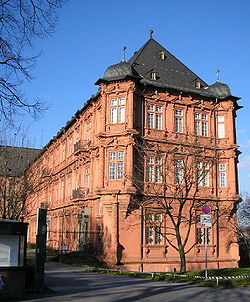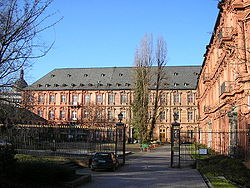
Electoral Palace Mainz
Encyclopedia



Mainz
Mainz under the Holy Roman Empire, and previously was a Roman fort city which commanded the west bank of the Rhine and formed part of the northernmost frontier of the Roman Empire...
is the former city Residenz
Residenz
Residenz is a very formal, otherwise obsolete, German word for "place of living". It is in particular used to denote the building or town where a sovereign ruler resided, therefore also carrying a similar meaning as the modern expressions seat of government or capital...
of the Archbishop of Mainz, who was also Prince-Elector
Prince-elector
The Prince-electors of the Holy Roman Empire were the members of the electoral college of the Holy Roman Empire, having the function of electing the Roman king or, from the middle of the 16th century onwards, directly the Holy Roman Emperor.The heir-apparent to a prince-elector was known as an...
of his electoral state within the Holy Roman Empire
Holy Roman Empire
The Holy Roman Empire was a realm that existed from 962 to 1806 in Central Europe.It was ruled by the Holy Roman Emperor. Its character changed during the Middle Ages and the Early Modern period, when the power of the emperor gradually weakened in favour of the princes...
. It is one of the important Renaissance buildings in Germany.
History
Originally the Archbishop of Mainz resided at the cathedralMainz Cathedral
Mainz Cathedral or St. Martin's Cathedral is located near the historical center and pedestrianized market square of the city of Mainz, Germany...
, where there is an old private chapel dating from 1137.
But in 1475, when the Chapter
Chapter (religion)
Chapter designates certain corporate ecclesiastical bodies in the Roman Catholic, Anglican and Nordic Lutheran churches....
re-elected Diether von Isenburg
Diether von Isenburg
thumb|Diethers coat of arms stained glass in Mainz Cathedral...thumb|... and as relief at the city walls of [[Höchst |Höchst]]Theodoric of Isenburg-Büdingen thumb|Diethers coat of arms stained glass in Mainz Cathedral...thumb|... and as relief at the city walls of [[Höchst (Frankfurt am...
, conditions were imposed: he had to surrender the town of Mainz to the Chapter, and erect a castle in the city. The construction of this Martinsburg began in 1478 and was completed two years later. For several decades, the archbishops lived either there or in the electoral palace at Aschaffenburg
Aschaffenburg
Aschaffenburg is a city in northwest Bavaria, Germany. The town of Aschaffenburg is not considered part of the district of Aschaffenburg, but is the administrative seat.Aschaffenburg is known as the Tor zum Spessart or "gate to the Spessart"...
, Schloss Johannisburg. After receiving damage during the second war with the margraves
Margrave
A margrave or margravine was a medieval hereditary nobleman with military responsibilities in a border province of a kingdom. Border provinces usually had more exposure to military incursions from the outside, compared to interior provinces, and thus a margrave usually had larger and more active...
in 1552 the castle was restored in a Renaissance style. Archbishop Daniel Brendel von Homburg built office buildings and St Gangolph's Church around the year 1580. (In order to make way for new avenues, these buildings as well as the Martinsburg were demolished by Napoleon during the French occupation of the town between 1798 and 1814.)
The building of a new palace commenced in 1627 on the behest of Archbishop Georg Friedrich von Greiffenklau
Georg Friedrich von Greiffenklau
Georg Friedrich von Greiffenklau zu Vollrads was the Bishop of Worms from 1616 to 1629 and the Archbishop-Elector of Mainz from 1626 to 1629.-Biography:...
. The Rhine wing of the new palace could not be finished until 1678, construction being delayed by the Thirty Years War and the War of the Grand Alliance
War of the Grand Alliance
The Nine Years' War – often called the War of the Grand Alliance, the War of the Palatine Succession, or the War of the League of Augsburg – was a major war of the late 17th century fought between King Louis XIV of France, and a European-wide coalition, the Grand Alliance, led by the Anglo-Dutch...
. The original plan is not known, but it was probably a four-wing construction, comparable to the 1604 repairs to Schloss Johannisberg. It can be assumed that Martinsburg remained standing only because of the delays.
The north wing was begun in 1687, ready by 1752, and furnished in succeeding years. Work on the wing extending away from the river was begun during the reigns of Johann Friedrich Karl von Ostein
Johann Friedrich Karl von Ostein
Johann Friedrich Karl von Ostein was the Prince-Bishop of Worms, Archbishop of Mainz and Elector of Mainz.He was a relative of Lothar Franz von Schönborn, a prior Archbishop-Elector of Mainz. On April 22, 1743 he was selected as a compromise candidate for Archbishop...
(1743—1763) and Friedrich Karl Josef von Erthal (1774—1802). Erthal was the last Prince-Elector of the old electorate. His successor Karl Theodor von Dalberg was both Archbishop-Elector of Mainz and Arch-Chancellor of the remaining Empire on the right bank of the Rhine. Due to the resolutions of the Reichsdeputationshauptschluss his seat was moved to Regensburg
Regensburg
Regensburg is a city in Bavaria, Germany, located at the confluence of the Danube and Regen rivers, at the northernmost bend in the Danube. To the east lies the Bavarian Forest. Regensburg is the capital of the Bavarian administrative region Upper Palatinate...
, which became the new seat of the archbishopric.
Delays were due not only to the War of the Grand Alliance, but also to the extensive building activity of the nobility: for example, the Lustschloss Favorite begun in 1700 by Lothar Franz von Schönborn
Lothar Franz von Schönborn
Lothar Franz von Schönborn was the Archbishop-Elector of Mainz from 1694 until 1729, and the Bishop of Bamberg from 1693 until 1729.Lothar Franz was born in Steinheim am Main in 1655 to Count Philip Erwin of Schönborn...
absorbed large amounts of resources. That summer residence was destroyed during the Siege of Mainz by coalition shelling in 1793
French Revolutionary Wars: Campaigns of 1793
The French Revolutionary Wars continued from 1792, with new powers entering the First Coalition after the execution of King Louis XVI. Spain and Portugal entered the coalition in January 1793, and on 1 February France declared war on Great Britain and the Netherlands.At the opening of the year,...
.
On 23 October 1792, the Jacobin Club
Jacobin Club
The Jacobin Club was the most famous and influential political club in the development of the French Revolution, so-named because of the Dominican convent where they met, located in the Rue St. Jacques , Paris. The club originated as the Club Benthorn, formed at Versailles from a group of Breton...
, a political group during the French Revolution, was established on what nowadays is German soil. This was the earliest democratic movement in Germany. The last Elector of Mainz was expelled in the same year, and the palace was neglected until 1827, when it was restored by the Grand Duchy of Hesse-Darmstadt and the City of Mainz.
During World War II
World War II
World War II, or the Second World War , was a global conflict lasting from 1939 to 1945, involving most of the world's nations—including all of the great powers—eventually forming two opposing military alliances: the Allies and the Axis...
, the building was heavily damaged, especially in the air raid of 27 February 1945, which destroyed most of the city. Of the palace, only the exterior walls remained. It was rebuilt during 1948 and 1949, reopened on 31 December 1949, and was the main venue in Mainz for Karneval activities until the Rheingoldhalle opened in 1968.
Architecture
Stylistically the Electoral Palace is one of the last examples of German Renaissance architecture. The northern wing, built later, conforms to this style. The exterior, with turrets at every corner, is richly decorated, particularly around the windows. The roofs have been restored with exactness. The most spectacular interiors included the Grand Staircase by the leading Baroque architect Balthasar NeumannBalthasar Neumann
Johann Balthasar Neumann , also known as Balthasar Neumann, was a [German] military artillery engineer and architect who developed a refined brand of Baroque architecture, fusing Austrian, Bohemian, Italian, and French elements to design some of the most impressive buildings of the period,...
, which was removed during the French occupation.
Modern uses
Today the east wing houses the Museum of Roman and Germanic History. An assortment of replicas and valuable original items presents a comprehensive picture of the cultural life of prehistoric times, of the Roman Empire, and of the early Middle Ages.The north wing contains the famous function hall from which the annual Karneval TV show Mainz bleibt Mainz, wie es singt und lacht is broadcast.
The Electoral Palace is now one of eight venues managed by Congress Centrum Mainz. There are seven halls and many smaller rooms, enabling events to be staged for up to 1,700 persons.

